The fish formerly known as Apistogramma sp. "Caquetá" [A 84] has been
scientifically described, as Apistogramma playayacu.
December 2011

(The picture is published with permission of PD Dr.habil.
Uwe Römer)
You'll find the complete description here:
Apistogramma playayacu sp. n.: Description of a new
cichlid species (Teleostei: Perciformes: Geophaginae) from the Río Napo system,
Ecuador
UWE RÖMER, JOSCHA BENINDE & INGO HAHN
xxxxxxxx
Apistogramma sp. "Matses"
November 2011
This species, with similarities, and some differences, with A. nijsseni and A.
panduro, might be the same as listed as Apistogramma sp. "Nijsseni-New".
Although the latter never showed any rows of blue spots in the caudal fins.
I collected this amazing new member of the A.-nijsseni-group in the
Río Galvez-drainage in October 2011.
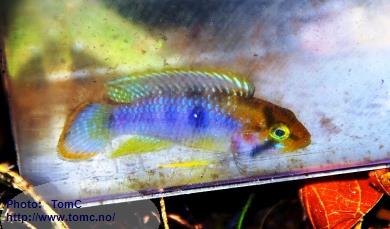
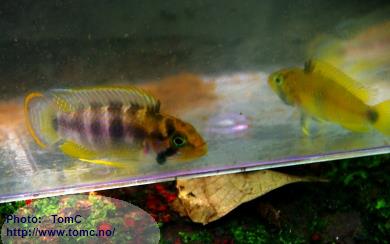
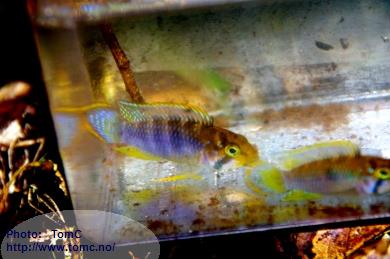
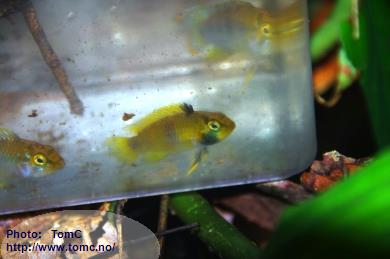
Our profile on Apistogramma sp. "Matses"
xxxxxxxx
Apistogramma sp. "Tahuayo" [A 79]
November 2011
As far as I know, this species hasn't been exported since the year 2000, so there
are probably not many of them around.
I was lucky and found and collected this beautiful member of the A.-eunotus-
subcomplex in the
Río Tahuayo-drainage in October 2011.
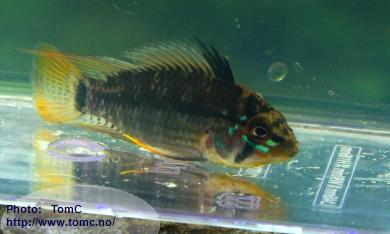
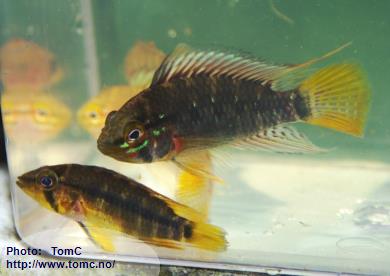
xxxxxxxx
Apistogramma sp. "Kosho-Kosho"
October 2011
Another "new" Apistogramma form, collected near Puerto Maldonado, Peru, in
September 2011.
This one seems to be close related to A. urteagai too.
It was named after a pet name the fisherman uses for his youngest son :-)
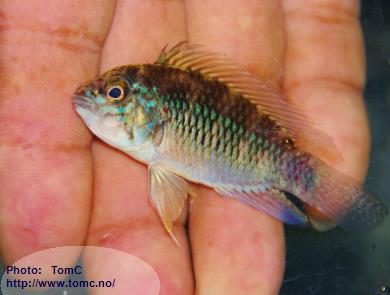
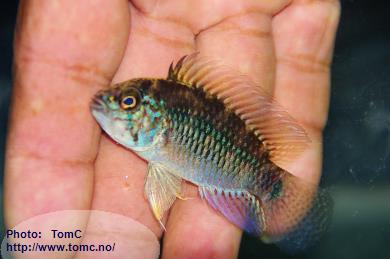
xxxxxxxx
A new form of Apistogramma?
October 2011
This Apistogramma was collected in the upper Río Itaya area, Peru, in July 2011.
Black markings like the cheek stripe and the caudal spot, and the low, even dorsal fin,
indicates a very close relationship with Apistogramma sp. "Oregon", but the
caudal fin shows vertical bars (!), and the abdominal spots forming kind of stripes,
indicates that this could be something new.
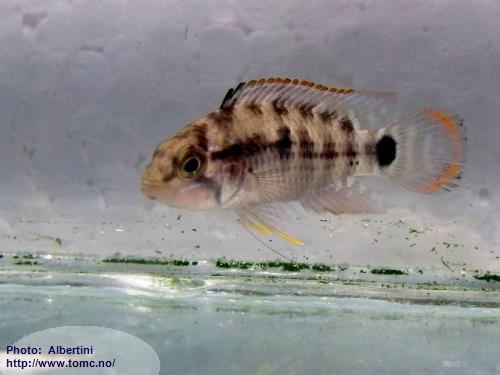
xxxxxxxx
Apistogramma (cf.) salpinction has been collected.
September 2011
This is probably the second photographs of a live A. (cf.) salpinction
ever.
The fish was collected not very far from Manaus, Brazil, by the young Apistogramma-
enthusiast Hudson Ensz in May 2011.
It is called a "cf." mainly because it was collected on the opposite side (southern)
of the Río Amazonas than where the original A. salpinction was found.
From the original description: "Distinguished from all other
species of Apistogramma by the color pattern, which includes a lateral band and
abdominal stripes which are darker and have much lighter interspaces on the caudal
peduncle, and which are extended onto the caudal fin base by a caudal spot divided into
elongated blotches continuing the lateral band and upper two abdominal stripes,
respectively."
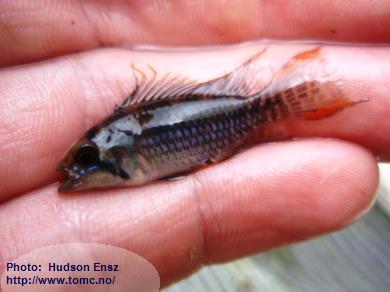
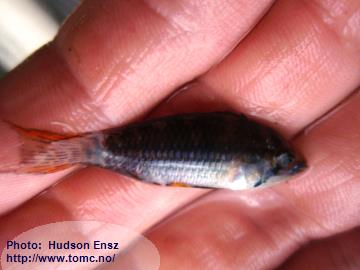
Want to see more of Hudson's world? His site could be found here:
http://passionate4pikes.wordpress.com/
xxxxxxxx
A new Apistogramma species collected near Puerto Maldonado, Peru
August 2011
The new species, collected by Jeff Cardwell, is probably related to A. urteagai.
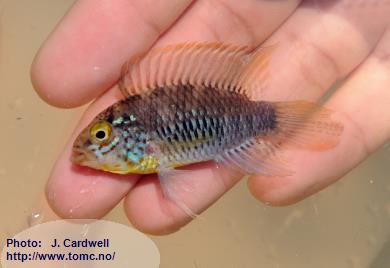
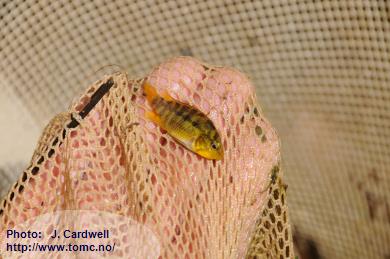
xxxxxxxx
The fish formerly known as Apistogramma sp. "Schwarzbrust" has been
scientifically described, as Apistogramma cinilabra.
April 2011
You'll find the complete description here:
Apistogramma cinilabra sp.n.: Description of a
potentially endangered endemic cichlid species (Teleostei: Perciformes: Cichlidae)
from the Departamento Loreto, Peru
Römer, Duponchelle, Diaz, Davilla, Sirvas, Catchay & Renno 2011
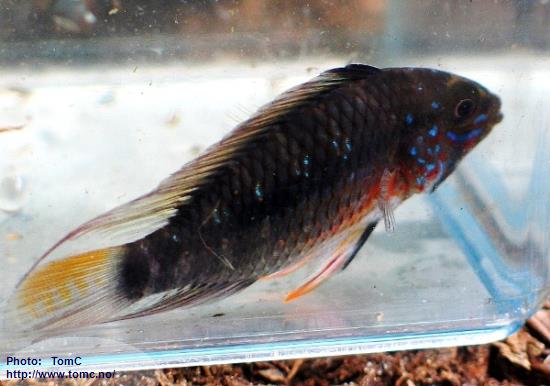
Our profile on A. cinilabra
xxxxxxxx
Apistogramma sp. "Rotpunkt"/cf. alacrina - new location found:
March 2011
A. Stalsberg collected this fish in March 2011, in the surroundings of Tena, Ecuador.
This collection increase our knowledge of the distribution range of A. sp.
"Rotpunkt"/cf. alacrina. The collecting location belongs to the upper Río Napo
drainage.
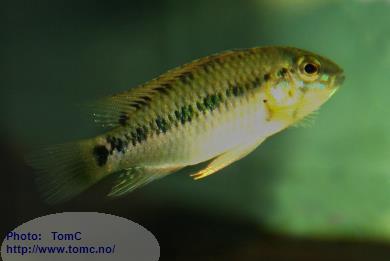
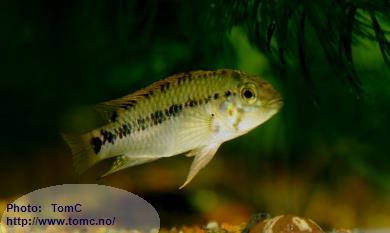
xxxxxxxx
Apistogramma sp. "Zwilling" - new location found:
November 2010
In October 2010, I found these exciting fishes in a tributary of a tributary of
the Río Tigre, Peru
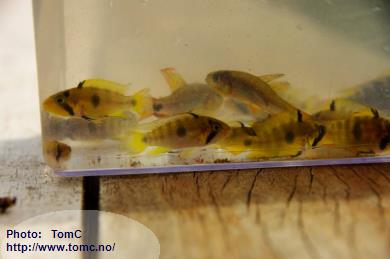
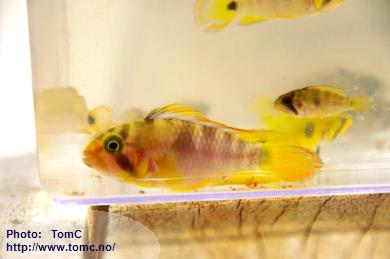
xxxxxxxx
A true beauty; Apistogramma bitaeniata from the Río Tigre
November 2010
I collected some of these in October 2010, in a very small tributary to the Río
Tigre, Peru
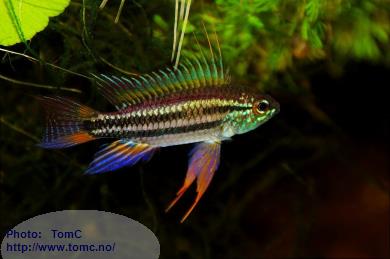
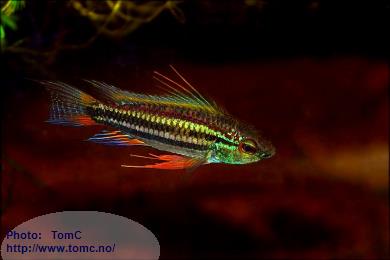
xxxxxxxx
Not so common in the hobby: Apistogramma cf. commbrae
November 2010
Collected by some friends of mine in November 2010, near Bella Union in Uruguay
It is a "cf." because the caudal spot is not totally separated from the bar 7.
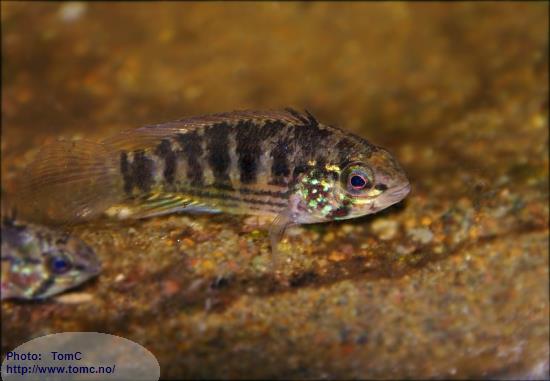
xxxxxxxx
Long time no see; Apistogramma sp. "Winkelfleck" (Dark form) [A 45]
October 2010
This amazing species was collected in October 2010.
They were found in a southern (right) tributary of the Río Amazonas, between Pebas
in Peru and Leticia in Colombia.
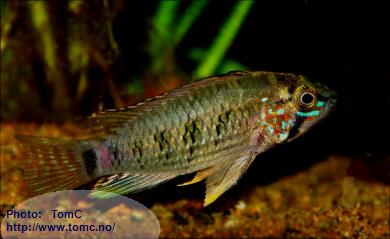
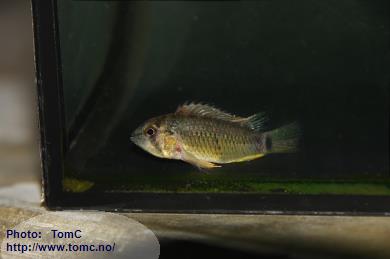
xxxxxxxx
A rare form of Apistogramma (cf.) luelingi from Río Urubamba, Peru
October 2010
These wonderful fishes were collected in October 2010.
They lack the black or black-ringed yellow or reddish stripes or spots that this
species some times shows in the upper part of the caudal fin, but it has the prominent
thick, slanting, and vertically-extending streaks on the lower part of the body.
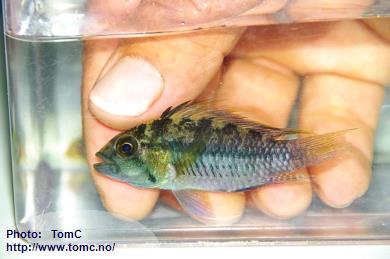
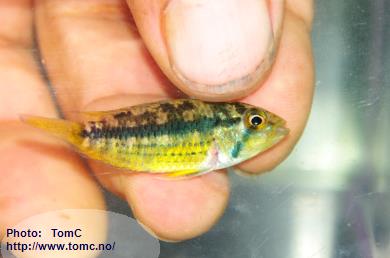
xxxxxxxx
An amazing color-form of Apistogramma eremnopyge.
October 2010
These fishes were collected in Peru in September 2010, amazingly in the Río Tigre
drainage! (New location = new population?)
Most of the males seem to have a lot more
blue markings and less red in the face.
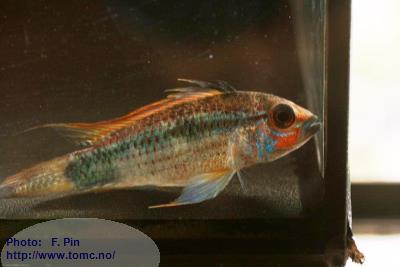
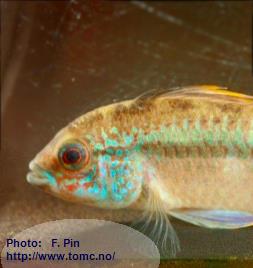
xxxxxxxx
A spectacular form of Apistogramma sp. (cf.) "Breitbinden" (Colombia).
August 2010
These wonderful fishes were collected in a small tributary to the Río Inirida in
July 2010, only about 1 km. from the possibly new species mentioned below.
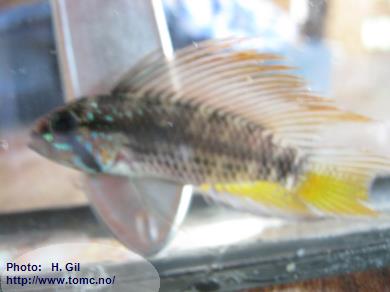
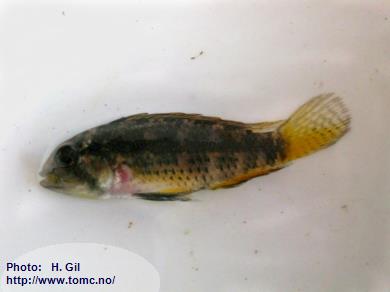
xxxxxxxx
A new(?) Apistogramma-brevis-group species intermediate between
A. sp. "Breitbinden" and A. personata.
July 2010
This possibly new species was collected in a small tributary to the Río Inirida,
Colombia, in June 2010.
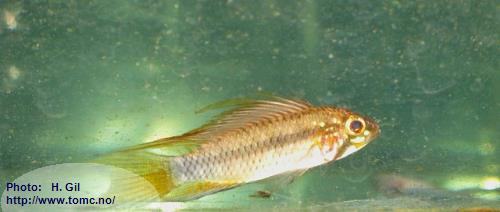
xxxxxxxx
Apistogramma (cf.) personata [A 172] has been collected
February 2010
Apistogramma (cf.) personata has not been seen for many years.
This might be the second time since Uwe Werner and his fellow travelers brought it back
in 1995.
A Japanese collector and a local fisherman collected the fish near the
town of Mitú, Río Vaupés drainage in Colombia, in January 2010.
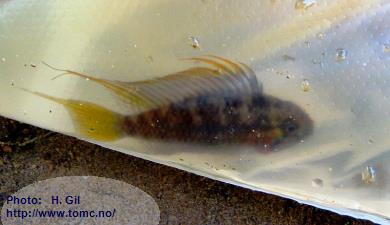
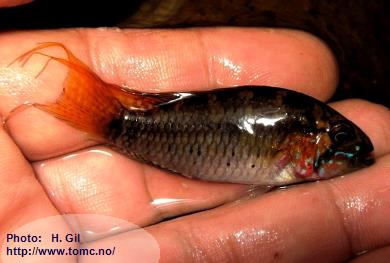
xxxxxxxx
Has the A. sp. "Kelleri" been collected in the Río Jutai (Brazil)?
December 2009
We met the fisherman who had collected these fishes in the Río Jutai, October 2009.
They look vey much like the A. sp. "Kelleri" which was collected in Leticia
(Brazil) in 2008.
It is sold in Germany as Apistogramma sp. "Diamond face". Of
course there are also similarities with A. barlowi
Male:
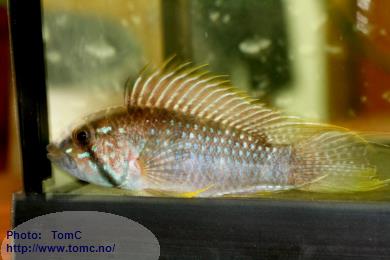
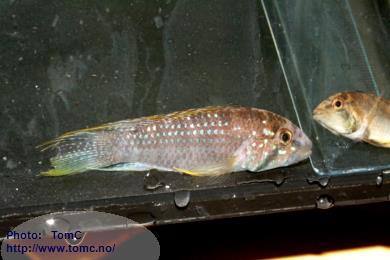
Female:
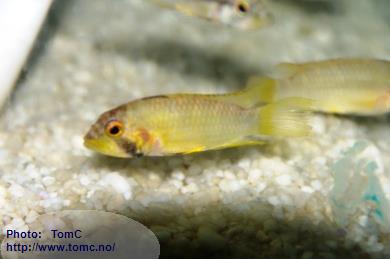
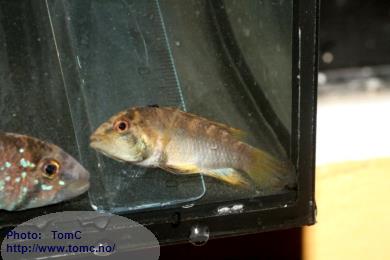
Update: This fish is not
from the Río Jutai; they were actually collected in the Leticia-area, Colombia, and
they are the same fish known as Apistogramma sp. "Kelleri".
xxxxxxxx
A new Apistogramma in the A.-cacatuoides-group (?) from Río
Jutai (Brazil)
October 2009
This fish was collected in Río Jutai, Brazil, in October 2009. Obviousely a new
species.
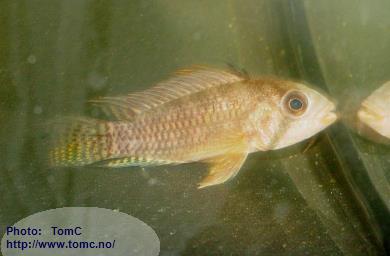
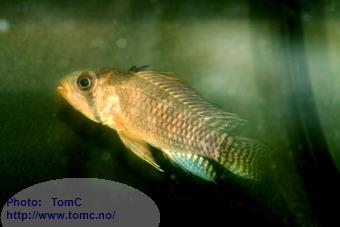
The "cheveron" pattern (here marked in red) reminds of the markings of A. staecki:
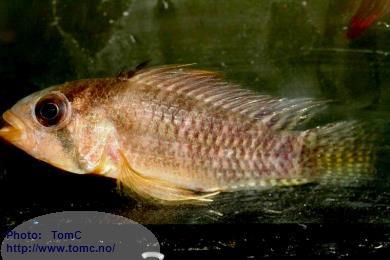
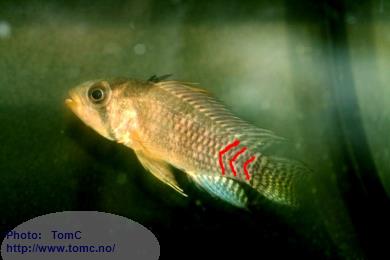
xxxxxxxx
Apistogramma sp. "Alto Tapiche" has been collected.
October 2009
In 2008 the japanese Minoru Matsuzaka bought a fish from a fisherman in Río
Tapiche,
and presented this picture of it:
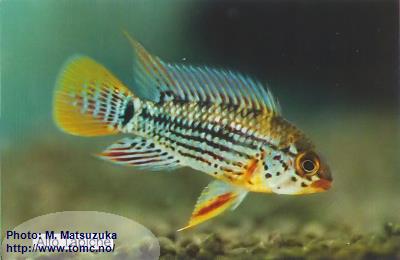
In October 2009, we decided that we wanted to find this fish and have a look at it's
habitat.
This brought us out on a 1136
km long trip on Río Ucayali and Río Tapiche,
AND WE FOUND IT!:
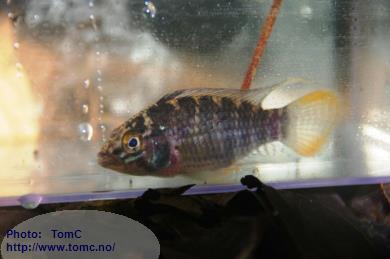
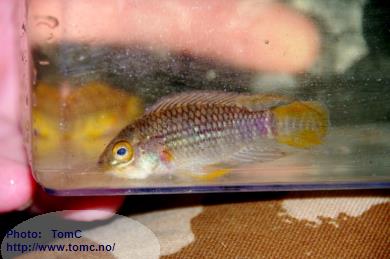
Similarities with Apistogramma rubrolineata and Apistogramma cf.
eunotus, but it was found a long distance from where these species lives.
This is, to me, obviousely a new species......
xxxxxxxx
Apistogramma sp. "Ruth" has been collected
October 2009
A fisherman presented the picture of this fish; he called it Apistogramma
sp. "Ruth" (after a member of his family):
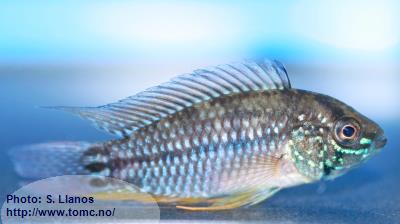
Of course we had to find it, collect it AND COUNT THE NUMBER OF HARD SPINES IN THE
ANAL FIN.
Then you all know what species we are talking about :-).
We found the fish where the locals had found it: among Water Hyasints in a rest water
pool near the mouth of the Río Itaya.
Although a well known species, the amount of blue pattern in the face and on the gill
covers is unusual.
Could it be a new form?
This is how it looked like in a bag:
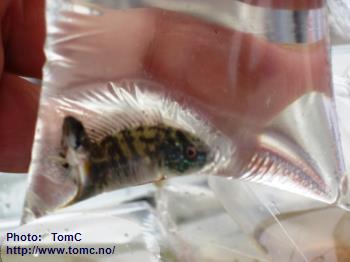
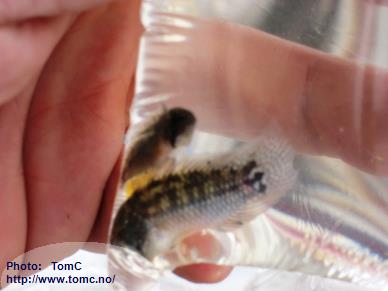
(For those who are not familiar with this species: It's Apistogrammoides
pucallpaensis)
xxxxxxxx
Apistogramma sp. aff. huascar has been collected
October 2009
This fish was collected in the Río Tapiche drainage. It looks like a A. huascar,
but it has a dorsal fin like A. sp. "Breitbinden" !
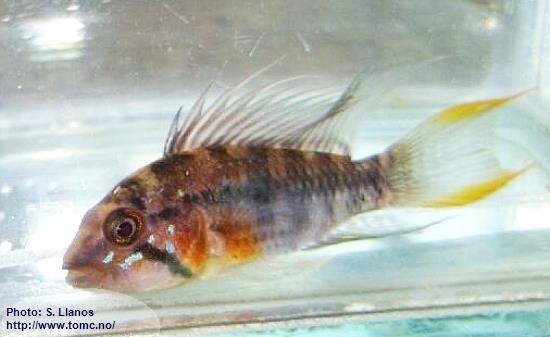
xxxxxxxx
3 "new" species were collected in the Río Napo drainage during the
October-2009 trip to the Peruvian Amazon:
October 2009
Apistogramma sp. "Río Napo 1"
This fish has much of the same
colors as fish from the Pebas-area, but it doesn't show any double caudal spot.
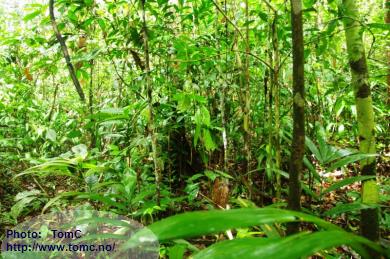
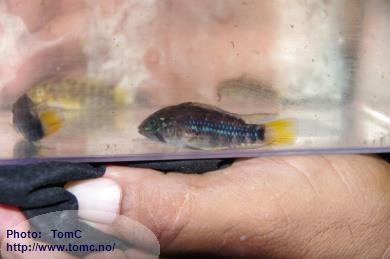
Apistogramma sp. "Río Napo 2"
This fish resembles a lot of
A. sp. "Rocka Eterna" (see below), but has a more slender body.
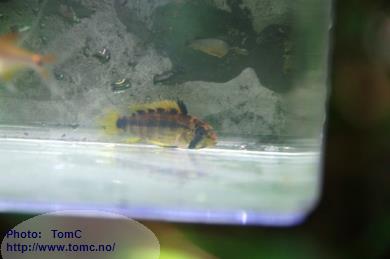
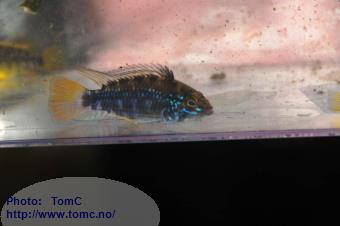
Apistogramma sp. "Río Napo 3"
This fish has many similarities
with A. cruzi, and the locals used that name for this fish. Could it be a color
form of A. cruzi?
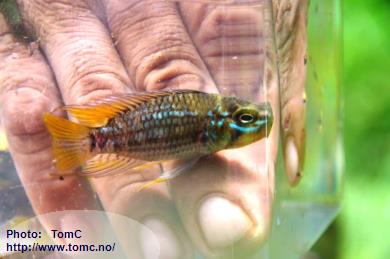
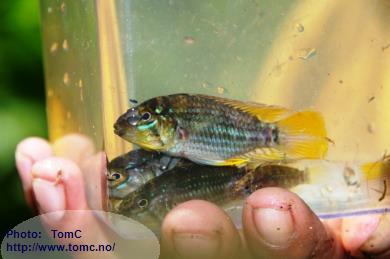
xxxxxxxx
Apistogramma sp. "Roca Eterna" has been brought home.
November 2008
From the trip to South America/Peru in 2008, we brought a species home that might
be a new species.
Obviousely an A. sp. "Pebas"-subcomplex fish:
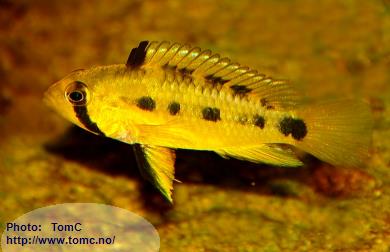
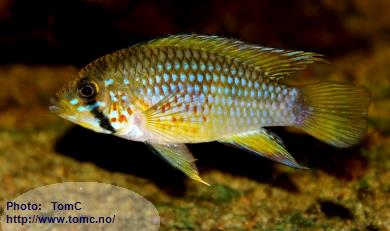
xxxxxxxx
Apistogramma sp. "Needle-stripes/Nadelstreifen" has been collected.
November 2008
During the trip to South America in October 2008, we went, on a short trip, to
Leticia, in Colombia.
Here, in the neighborhood of the town Leticia, we collected
this very seldom collected species, in small streams. A few fishes were
brought back home to Norway.
I. KOSLOWSKI considers this unic species as a bridge
between the A. eunotus - subcomplex and the A. cruzi - subcomplex.
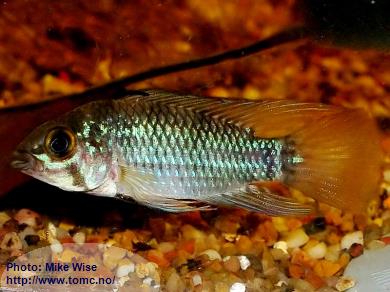
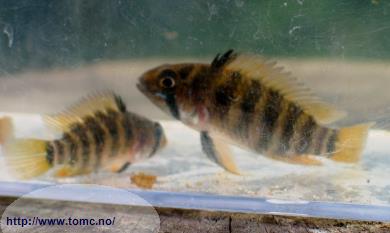
Our profile on A. sp. "Needle-stripes/
Nadelstreifen" is found here
xxxxxxxx
The fish formerly known as Apistogramma sp. "Río Mamoré" has
been scientifically described, as Apistogramma erythrura
November 2008
You'll find the complete description here:
Apistogramma erythrura sp. n. - a new geophagine
dwarf cichlid (Teleostei: Perciformes: Cichlidae) from the Río Mamoré drainage in
Bolivia
Wolfgang Staeck & Ingo Schindler
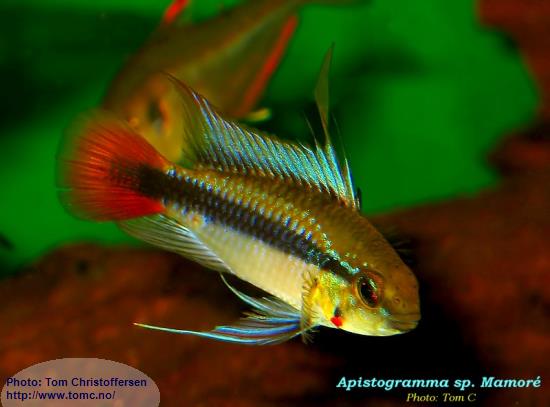
Our profile on A. erythrura
xxxxxxxx
Another new Apistogramma in the A.-nijsseni-group, from Peru
June 2008
Have you ever seen an Apistogramma-nijsseni-group fish with spots in
the anal fin ?
Well, here you can see one:
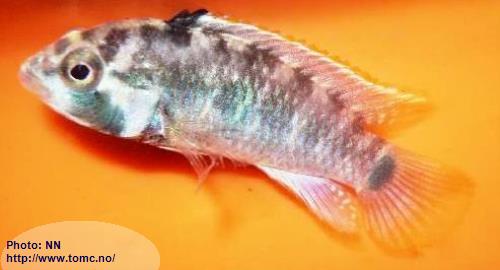
xxxxxxxx
A new Apistogramma-form from Peru?
May 2008
A new form of Apistogramma in the A.-eunotus-complex has been
collected; it has a strange bar 7 and caudal spot:
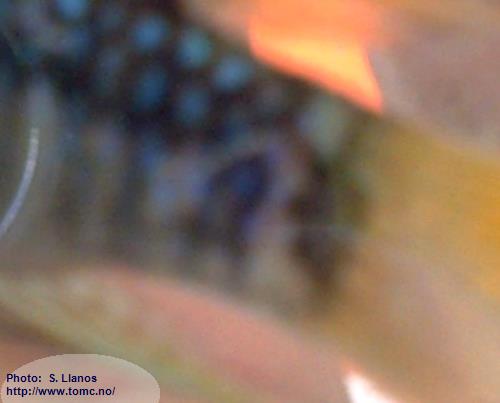
Updated November 2008: We collected it
in October 2008.
A report from the expedition can be found here,
and
a profile on the fish is here.
xxxxxxxx
Another form of Apistogramma cf. eunotus.
May 2008
The fish clearly shows a horizontally split caudal spot that is rather unusual
(similar to the caudal spot seen on some Río Algodón populations of A.
sp. "Putumayo").
It appears to be closely related to the typical Orangeschwanz form of A.
cf. eunotus.
It is called Apistogramma cf. eunotus
"Spaltenfleck /Split-Spot".
We got the information and the pictures of
this new fish from my good friend Mark Breeze (UK).
Updated July 2008: Studies of preserved
fish now indicates that this probably is an entirely new species, not a form
of A. cf. eunotus.
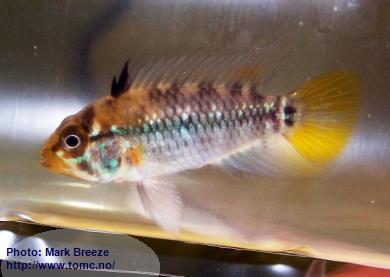
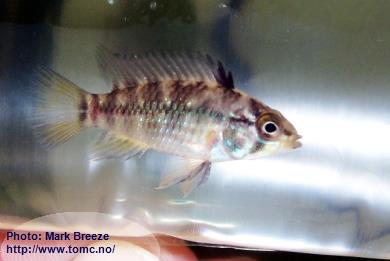
xxxxxxxx
Apistogramma sp. "Maulbrüter" / "Mouthbrooder" has been described,
as Apistogramma barlowi
May 2008
Late 2007, U. Römer & I. Hahn described it, and named it after Dr. George
W. Barlow, one of the most eminent cichlid researcher of the past half century -
especially in cichlid behavior.
Dr. Barlow also wrote the very interesting book
"The cichlid fish. Nature's grand experiment in evolution"
Apistogramma barlowi sp. n.: Description of a new
facultativ mouth-breeding cichlid species
(Teleostei: Perciformes: Geophaginae)
from Northern Peru
U. Römer & I. Hahn 2007
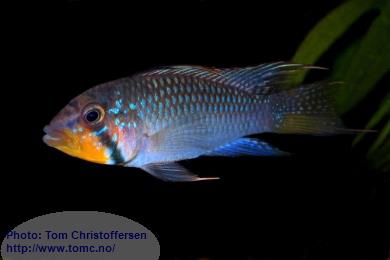
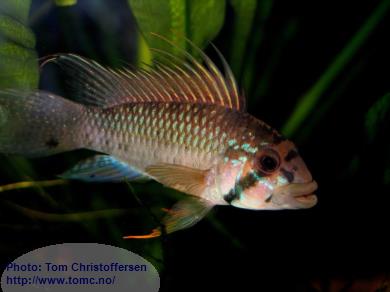
Our profiles on A. barlowi: The red/blue color form
The white color form
xxxxxxxx
The rediscovery of Apistogramma cf. payaminonis.
January 2008
In Desember 2007, a few specimens of a "new" Apistogramma came in
to the Stingray Aquarium, in Iquitos, Peru.
A fisherman had collected them "close to the border Peru/Ecuador", and so far
the more excact collecting location is not known.

KÄSTNER (2000) introduced a dwarf cichlid as A. payaminonis that has
great similarities to the A. payaminonis known from Ecuador, but with some
differences.
His specimens arrived in a regular import from Manaus, Brazil:
this rule against an identity with A. payaminonis. The explanation is
believed to be found in the trade of fish from Peru/Ecuador to Brazil.
The latest discovery of this fish, close to the border Peru/Ecuador, confirms
that the fish originally comes from areas far from Brazil, and also makes the
identity close to A. payaminonis more logic.
xxxxxxxx
The true (?) Apistogramma cruzi has been collected.
November 2007
On my last collection trip to the Amazon, in October 2007, I followed in the
footsteps of dr. Kullander to the Río Mazan, and I found this beauty:
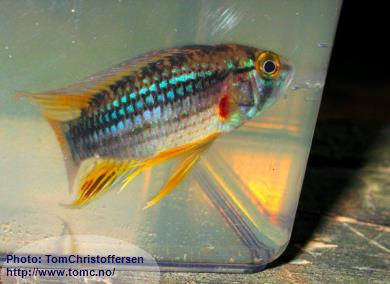
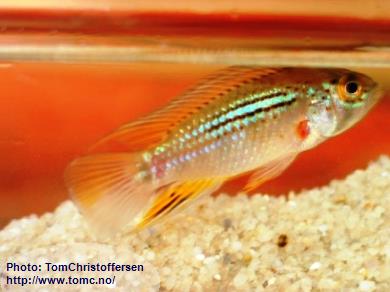
xxxxxxxx
A (new ?) Apistogramma form from Picuruyacu (Peru)
November 2007
On my last collection trip to the Amazon, in October 2007, I found this fish
in a pond in Picuruyacu. The fish has similarities with A. cruzi,
A. sp. "Nanay/Melgar", and even A. moa(?).
The name, until the fish is further examined, is Apistogramma sp.
aff. cruzi (Picuruyacu).
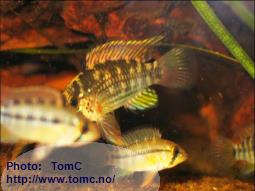
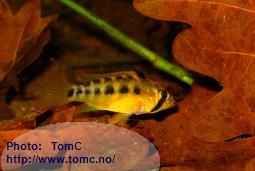
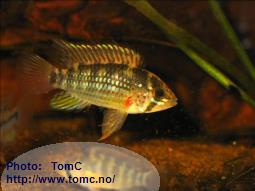
xxxxxxxx
Three color forms of Apistogramma sp. "Nanay / Melgar"
November 2007
On my last collection trip to the Amazon, in October 2007, I found and
collected these fishes in different locations in Loreto, Peru.
From left to
right: Apistogramma sp. "Nanay/Melgar I" (Punchana), Apistogramma
sp. "Nanay/Melgar II" (Río Nanay), and Apistogramma sp. "Nanay/Melgar"
"Bleeding heart"(Laguna de Quistococha):
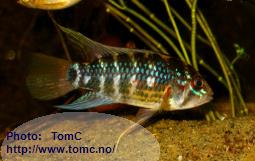
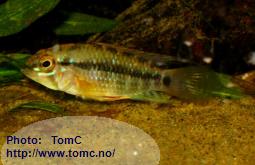
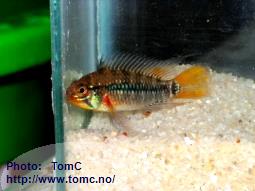
xxxxxxxx
A new form of Apistogramma cf. eunotus from the Río Huallaga
drainage.
November 2007
In August/September 2007, a new form of A. cf. eunotus was
collected in the Río Huallaga drainage, north of Tarapoto (Peru).
Like
A. cf. eunotus (Schwanzsterifen/Tail-stripes)[A 77] it has a
distinct pattern in the caudal fin.
It is called Apistogramma cf.
eunotus (Río Huallaga).
Here are pictures of both sexes, shot in
one of my tanks:
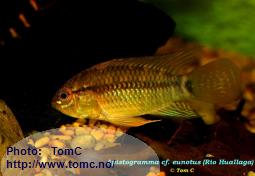
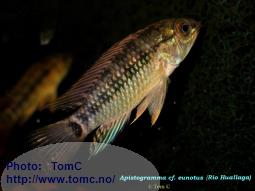
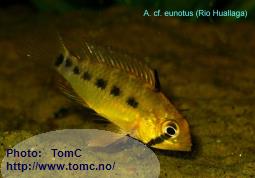
xxxxxxxx
A new Apistogramma has been discovered.
August 2007
It was found in south-east Colombia, early in 2007.
It is so far given
the name Apistogramma sp. "Kelleri". It seems to be closely related
to Apistogramma sp. Maulbruter/Mouthbrooder.
Whether it is a
mouthbrooder like its relative, is so far not known.
xxxxxxxx
A new form of Apistogramma huascar has been found in Peru.
August 2007
So far, the collecting location is a "trade secret".
Let's hope aquarists
keep aware of the differences, and don't mix / crossbreed these two forms.
I have marked the differences between the original and the new form:
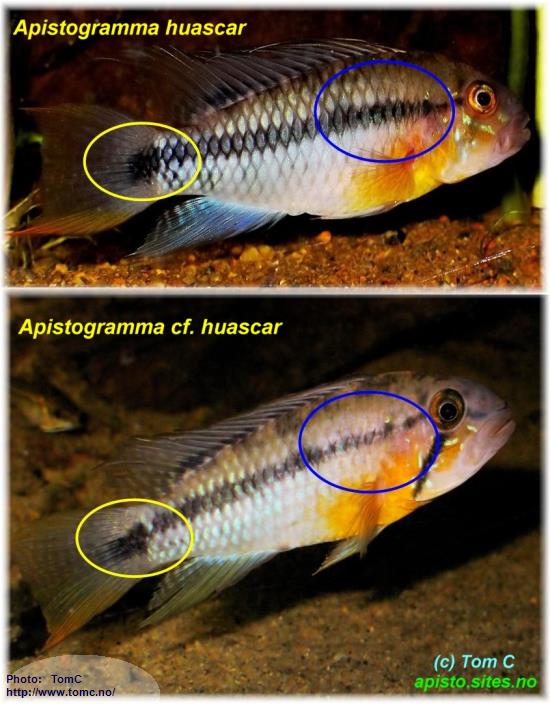
xxxxxxxx